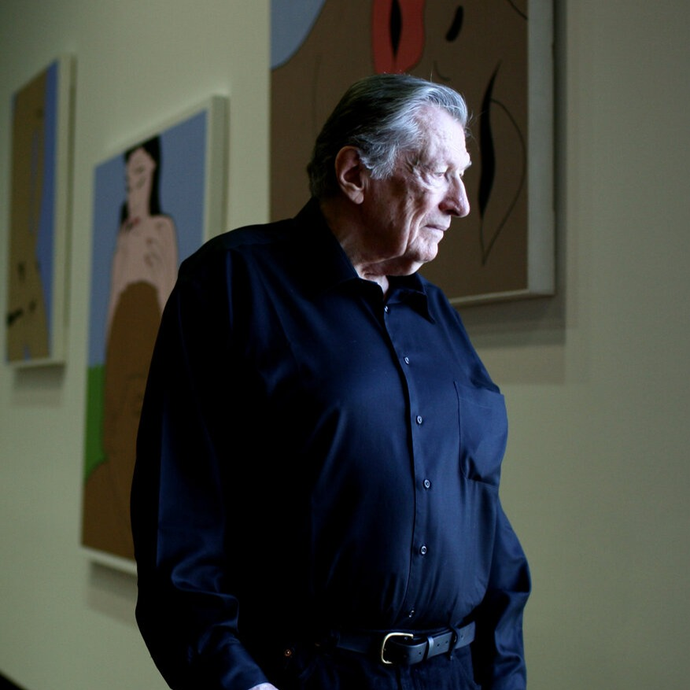
John Wesley
John Wesley, an American artist, gained renown for his distinctive figurative creations that combined elements of desire and humor. He showcased his art alongside notable Pop artists such as Andy Warhol, Tom Wesselman, and Roy Lichtenstein. However, he defied straightforward classification in both theory and execution, primarily due to the distinctive and unparalleled nature of his visual language.
Biography of John Wesley
John Wesley was born in 1928 in Los Angeles, California, USA.
In the early 1950s, John Wesley delved into creating abstract expressionist artworks, even though he had no formal training in the field. Over time, he chose to pursue his passion more seriously and began attending evening art classes while simultaneously working as a dishwasher, warehouse stocker, and aircraft riveter.
Starting in 1953, he began a five-year tenure in the illustration department at Northrop Aircraft Corporation. During this period, his role primarily involved converting complex blueprints into simpler drawings. In 1960, he moved to New York with his second wife, Jo Baer, an artist associated with minimalism. There, he took on the role of a postal clerk to support their artistic pursuits and livelihood.
During this period, Wesley developed particularly strong personal connections with prominent minimalist creators, including Donald Judd, Dan Flavin, Robert Ryman, and Sol LeWitt.
In 1963, he held his inaugural individual exhibition at the Robert Elkon Gallery in New York.
On February 10, 2022, John Wesley passed away at his residence in Manhattan.
Wesley's impact on the world of painting is undeniable, and his creations are housed in public collections around the world. Notable institutions holding his work include the Chinati Foundation in Marfa, Texas; the Hirshhorn Museum and Sculpture Garden in Washington, D.C.; the Kunstmuseum in Basel; The Museum of Modern Art and the Whitney Museum of American Art, both located in New York.
John Wesley's Art Style
Wesley's artistic preoccupations and distinctive style showcased their peculiar and unique attributes as far back as 1963. During this time, he skillfully placed cartoonish, emotionally charged depictions of both groups and individuals, including historical personages, within empty expanses. In the mid-1960s, this visual repertoire transitioned into disquieting depictions characterized by an erotic essence. Wesley's paintings featured nude and partially clothed figures, often female subjects, alongside personified frogs, camels, bears, apes, birds, and squirrels.
During the 1970s, Wesley shifted toward more expansive compositions, characterized by an infusion of intensified color schemes. These palettes were rich in shades of candy pink, baby blue, flesh-toned beige, and clinical hospital green. Thematically, his works often adopted a farcical yet incisive perspective on subjects like gender relations, paternal authority, and the inevitability of mortality.
In 1973, Wesley embarked on an enduring exploration that extended into the 2000s, involving iconic characters from popular 1950s comic strips such as Blondie, Popeye, and Dennis the Menace.
Throughout the 1980s, he often emphasized formal elements. This was evident in his creation of frieze-like compositions featuring repeated depictions of nudes, as seen in works like "Hips" from 1984. Additionally, he skillfully arranged animals in decorative patterns reminiscent of wallpaper designs, exemplified by pieces such as "Untitled (Horse and Clouds)" from 1988.
Across the span of his artistic journey, Wesley consistently drew upon and recontextualized imagery from popular media for his creative endeavors. Employing a comic-strip aesthetic characterized by flat forms, intricate black contours, a restrained yet vibrant range of colors, and refined, minimalist arrangements, Wesley's artwork often featured a variety of themes. These included playful nymphs, nude figures, children and animals, idyllic landscapes, significant historical moments, and even 1950s comic strip characters. Through a lens of humor and audacious irreverence, his pieces provocatively depicted enigmatic scenarios of forbidden desire, fury, or desolation.
Years:
Born in 1928
Country:
United States of America, Los Angeles, California